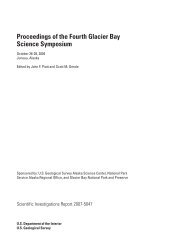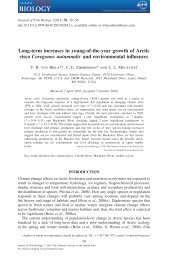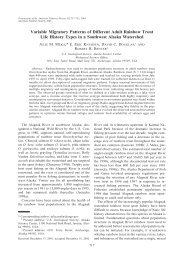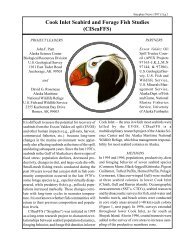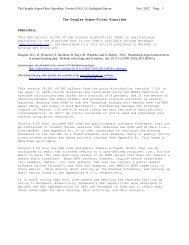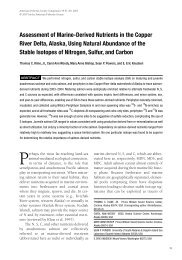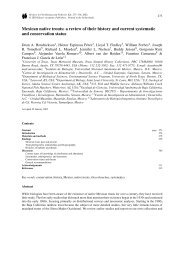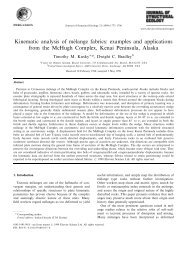Environ Biol Fishclassic high otolith Sr/Ca signal presumed to indicateresidence in high salinity environments. The Tumnin<strong>taimen</strong> were not characterized by similarly high Sr/Cavalues, but one fish had clearly migrated to highersalinity conditions (Tumnin 3). The other two fishappeared to have just migrated to saltwater beforecapture. The Koppi River <strong>taimen</strong> were characterizedby two patterns <strong>of</strong> otolith Sr/Ca: (1) little variationwith moderate Sr/Ca values (i.e., 1.2×10 −3 to 1.5×10 −3 ) and (2) transects punctuated by peaks in Sr/Ca>1.5×10 −3 (i.e., lower than peaks observed in presumedsaltwater migrants; Tumnin 3 and Sarufutsusamples).We used the Sarufutsu River and Tumnin Riversamples to guide classification <strong>of</strong> the Koppi River<strong>taimen</strong>. Without translocation or rearing studies todetermine the relation between salinity and otolith Sr/Cafor <strong>taimen</strong>, however, it is difficult to determine athreshold value associated with movement into seawaterfor this study. For example, Zimmerman (2005) raisedjuvenile salmon, trout, and char in laboratory tankswith salinity increasing in 2 week intervals to validatethe relationship between otolith Sr/Ca and increasingsalinity. Otolith Sr/Ca differed among species at thesame salinity suggesting that it was not appropriateto compare values among species (Zimmerman2005). Further, Zimmerman (2005) cautioned thatotolith Sr/Ca provides only enough resolution tobroadly classify otolith material deposited in freshwater,brackish, or saltwater.Arai (2010) conducted rearing studies using <strong>taimen</strong>and confirmed that otolith Sr/Ca ratios were correlatedwith ambient salinity. Arai (2010) found that otolithSr/Ca was linearly related to ambient salinity andotolith Sr/Ca in freshwater was 1.84×10 −3 , increasedto approximately 3.0×10 −3 in brackish water (salinity=11 psu), and was approximately 5.0×10 −3 in fullseawater (salinity=33 psu). Based on those results, athreshold otolith Sr/Ca value <strong>of</strong> approximately 2.5×10 −3 could be used to discriminate freshwater andsaltwater growth. Using this value, none <strong>of</strong> the KoppiRiver fish would be classified as saltwater migrants.We were unable, however, to directly compare ourresults, nor select a threshold value for the transition tosaltwater, from Arai (2010) because <strong>of</strong> differences ininstrumentation between the two studies. Although weanalyzed the masu salmon and white spotted char toprovide a benchmark for otolith Sr/Ca transects inexpected migratory species from the Koppi River, wecannot directly apply thresholds based on these transectsto the <strong>taimen</strong> collected from the Koppi River. They do,however, suggest that otolith Sr/Ca deposited in theKoppi River can be distinguished from otolith Sr/Cadeposited in marine environments.Because the Tumnin River <strong>taimen</strong> were captured inset-nets outside the mouth <strong>of</strong> the river, we expected t<strong>of</strong>ind elevated Sr/Ca reflecting migration to seawater.Only one <strong>of</strong> the samples (Tumnin 3) was characterizedby increased Sr/Ca, and these values were onlyobserved in the year <strong>of</strong> capture, indicating the fish hadjust migrated to seawater; based on the location <strong>of</strong>capture, these fish were presumed to have enteredseawater, however, only one showed evidence based ona Sr/Ca signature in the otolith. As a result, it isimportant to recognize that short duration migrations tosaltwater (or very recent migrations to saltwater) maynot result in increased otolith Sr/Ca. It is, therefore,likely that frequent short migrations to estuarine or nearshorehabitats (amphidromous migrations) would not becaptured by analysis <strong>of</strong> transects <strong>of</strong> otolith Sr/Ca.Because the temporal resolution <strong>of</strong> the 10 μm beamused to measure Sr/Ca varies across the otolith transect, itis difficult to compare among years within the same fish.For example, in Koppi River <strong>taimen</strong> 3, with uniformsampling across annual growth increments, the first year<strong>of</strong> life contains 13 probe measurement points while lateryears contain only two or three points (Fig. 6). A pointmeasured in the first year <strong>of</strong> life is sampling otolithmaterial deposited over a mean <strong>of</strong> 28 d, whereas at age10 the same point is sampling material deposited overapproximately 180 d. It is likely, therefore, that shorttermmigrations at later ages are not adequatelyrepresented in the life history transects. Further workexamining otolith Sr/Ca <strong>of</strong> fish <strong>of</strong> known migrationhistory is needed to determine patterns associated withamphidromous species that may make sub- annualmigrations between environments <strong>of</strong> differing salinities.Yamashiro (1965), as cited in Edo et al. (2005),suggested that smolting <strong>of</strong> <strong>Sakhalin</strong> <strong>taimen</strong> mightoccur at age 2–3 based on growth rates. SarufutsuRiver <strong>taimen</strong> 1 made an initial migration to sea at age3 (Fig. 4a). Sarufutsu River <strong>taimen</strong> 2, however, wascharacterized by otolith Sr/Ca values as high as 2.5×10 −3 from its first year <strong>of</strong> life through age-4 (Fig. 4b).It is not clear if this fish was migrating to brackishwater from age-0 to age-8 and then migrated tosignificantly higher salinity environments at age-9, orif it was rearing in freshwaters <strong>of</strong> higher Sr content.
Environ Biol FishFurther work is needed to assess the role <strong>of</strong>freshwater productivity in controlling migratory behaviorin <strong>Sakhalin</strong> <strong>taimen</strong> while controlling forwatershed area and development. Fukushima et al.(2011) found that watersheds <strong>of</strong> lower topography andextensive wetland and brackish lagoons were importantfactors in describing the distribution and conservationstatus <strong>of</strong> <strong>Sakhalin</strong> <strong>taimen</strong>. The eastern shore <strong>of</strong>Khabarovsk Krai or the western shore <strong>of</strong> <strong>Sakhalin</strong>Island would provide an ideal set <strong>of</strong> streams to testhypotheses concerning the role <strong>of</strong> freshwater productivityand watershed level controls on life history andproductivity <strong>of</strong> <strong>taimen</strong>.Given the conservation status <strong>of</strong> <strong>taimen</strong>, this studyand others are constrained by small samples sizes. Incombination, otolith microchemistry has been used todescribe migratory behavior in only a total <strong>of</strong> 31<strong>Sakhalin</strong> <strong>taimen</strong>: 13 in this study, eight in Arai et al.(2004), and ten in Honda et al. (2010). These resultssuggest that there are existing gaps in our knowledge<strong>of</strong> <strong>taimen</strong> behavior and ecology. It is clear thatdiadromous migrations are conducted by <strong>Sakhalin</strong><strong>taimen</strong> (Arai et al. 2004; Honda et al. 2010), but it isnot clear whether these migrations are annual (asobserved in amphidromous species such as DollyVarden Salvelinus malma; Armstrong 1974), or if<strong>taimen</strong> overwinter in seawater. Further, it is not clearwhat proportion <strong>of</strong> <strong>Sakhalin</strong> <strong>taimen</strong> are diadromousand how that proportion is controlled by watershedand estuarine productivity. Further work is needed todescribe migratory behavior in <strong>taimen</strong> with anemphasis on determining duration <strong>of</strong> marine residence,stray rates among streams, use <strong>of</strong> overwintering habitat,and how migratory behavior is controlled by watershedand estuarine productivity.Acknowledgments Robert Oscarson, lab manager <strong>of</strong> theUSGS Electron Microprobe Laboratory, Menlo Park, Californiaassisted with microchemical analysis <strong>of</strong> otoliths. Discussionswith John Seigle concerning determination <strong>of</strong> migratorybehavior based on otolith microchemistry helped to improvethe study. Funding was provided by the National GeographicSociety, Disney Worldwide Conservation Fund, and the ForestBureau <strong>of</strong> the Taiwan Council <strong>of</strong> Agriculture. Funding forotolith analyses was provided by the U.S. Geological Survey.Comments from Gordon Reeves, Robert Gresswell, andKentaro Morita on earlier versions <strong>of</strong> this manuscript werevery helpful. In addition, we thank two anonymous reviewersfor comments that further improved this manuscript. Mention<strong>of</strong> trade names does not constitute endorsement by the USGovernment.ReferencesArai T (2010) Effect <strong>of</strong> salinity on strontium:calcium ratios inthe otoliths <strong>of</strong> <strong>Sakhalin</strong> <strong>taimen</strong>, Hucho <strong>perryi</strong>. Fish Sci76:451–455Arai T, Morita K (2005) Evidence <strong>of</strong> multiple migrationsbetween freshwater and marine habitats <strong>of</strong> Salvelinusleucomaensis. J Fish Biol 66:888–895Arai T, Tsukamoto K (1998) Application <strong>of</strong> otolith Sr:Ca ratiosto estimate the migratory history <strong>of</strong> masu salmon,Oncorhynchus masou. Ichthyol Res 45:309–313Arai T, Kotake A, Morita K (2004) Evidence <strong>of</strong> downstreammigration <strong>of</strong> <strong>Sakhalin</strong> <strong>taimen</strong>, Hucho <strong>perryi</strong>, asrevealed by Sr:Ca ratios <strong>of</strong> otolith. Ichthyol Res 51:377–380Armstrong RH (1974) <strong>Migration</strong>s <strong>of</strong> anadromous Dolly Varden(Salvelinus malma) in southeastern <strong>Alaska</strong>. J Fish Res BdCan 31:435–444Brown RJ, Severin KE (1999) Elemental distribution withinpolymorphic inconnu (Stenodus leucichthys) otoliths isaffected by crystal structure. Can J Fish Aquat Sci56:1898–1903Donohoe CJ, Zimmerman CE (2010) A method <strong>of</strong> mountingmultiple otoliths for beam-based microchemical analyses.Env Biol Fish. doi:10.1007/s10641-010-9680-3Edo K, Kawaguchi Y, Nunokawa M, Kawamula H, Higashi S(2005) Morphology, stomach contents and growth <strong>of</strong> theendangered salmonid, <strong>Sakhalin</strong> <strong>taimen</strong> Hucho <strong>perryi</strong>,captured in the Sea <strong>of</strong> Okhotsk, northern Japan: evidence<strong>of</strong> an anadromous form. Env Biol Fish 74:1–7Fukushima M (1994) Spawning migration and redd construction<strong>of</strong> <strong>Sakhalin</strong> <strong>taimen</strong>, Hucho <strong>perryi</strong> on north HokkaidoIsland, Japan. J Fish Biol 44:877–888Fukushima M, Shimazaki H, Rand PS, Kaeriyama M (2011)Reconstructing <strong>Sakhalin</strong> <strong>taimen</strong> <strong>Parahucho</strong> <strong>perryi</strong> historicaldistribution and identifying causes for local extinctions.Trans Am Fish Soc 140:1–13Holcik J, Hensel K, Nieslanik J, Skacel L (1988) The Eurasianhuchen, Hucho hucho: largest salmon <strong>of</strong> the work. Dr. W.Junk, DordrechtHonda K, Arai T, Takahashi N, Miyashita K (2010) Life historyand migration <strong>of</strong> <strong>Sakhalin</strong> <strong>taimen</strong>, Hucho <strong>perryi</strong>, caughtfrom Lake Akkeshi in eastern Hokkaido, Japan, asrevealed by Sr:Ca ratios <strong>of</strong> otoliths. Ichthyol Res57:416–421Ingram BL, Sloan D (1992) Strontium isotopic composition <strong>of</strong>estuarine sediments as paleosalinity-paleoclimate indicator.<strong>Science</strong> 255:68–72Kalish JM (1990) Use <strong>of</strong> otolith microchemistry to distinguish theprogeny <strong>of</strong> sympatric anadromous and non-anadromoussalmonids. Fish Bull 88:657–666Kalish JM, Beamish RJ, Brothers EB, Casselman JM, FrancisRICC, Mosegaard H, Panfili J, Prince ED, Thresher RE,Wilson CA, Wright PJ (1995) Glossary for otolith studies.In: Secor DH, Dean JM, Campana SE (eds) Recentdevelopments in fish otolith research. Baruch LibraryMarine <strong>Science</strong> No. 19. pp 723–729Kawamura H, Mabuchi M, Yonekawa T (1983) The Japanesehuchen, Hucho <strong>perryi</strong> (Brevoort), collected in brackishwater Lake Akkeshi, eastern Hokkaido, Japan. Sci Rep




